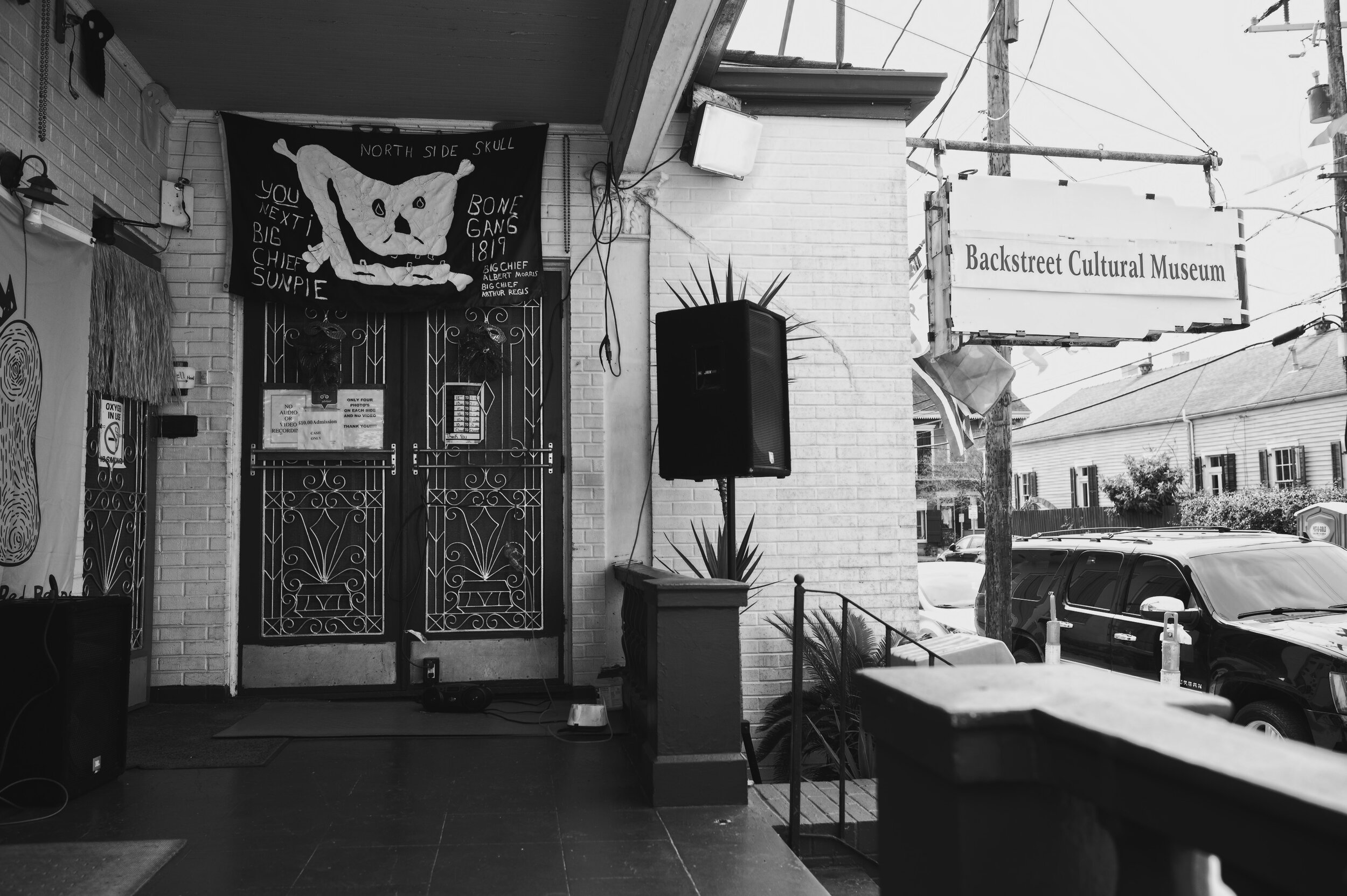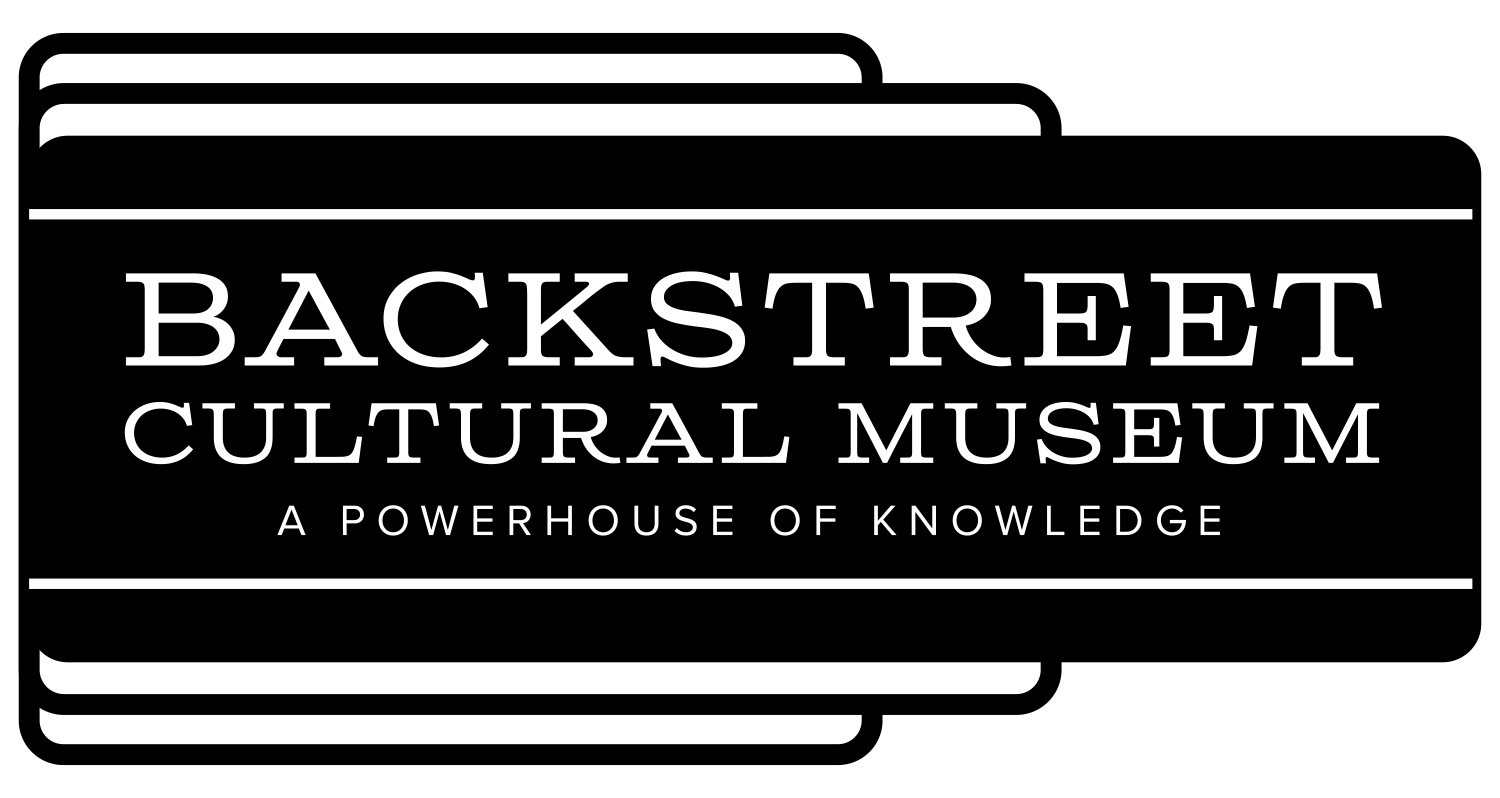
HISTORY
In his mind, he was merely providing a service: “One of my main goals was—I like this culture so much—that if I was to take anybody’s picture, I’d give them a copy.” Little did he know, his generosity would be returned to him over the years in the form of Mardi Gras Indian costumes and an array of other cultural artifacts and memorabilia that today make up the Backstreet Cultural Museum.
In 1988, Francis began displaying his photographs and Mardi Gras Indian memorabilia in his two-car garage in the “back streets” of the historic Tremé neighborhood. When Chief Victor Harris of the Mandingo Warriors “Spirit of Fi Yi Yi” Mardi Gras Indians and social aid and pleasure club members heard about the display, they donated costumes and parade umbrellas. During this period, Francis developed invaluable relationships with Mardi Gras Indians, culture bearers, and parade followers. As the “baby museum” grew, so did the attention it received.
Francis’ friend and former employer, Joan Brown Rhodes, of the Rhodes Funeral Home, immediately recognized the collection’s potential and began bringing tour groups to view it. When the Rhodes’-owned Blandin Undertaking Co. on St. Claude Avenue closed, Ms. Rhodes suggested that the exhibition move into the building. While Francis was hesitant at first, he finally accepted the offer and the Backstreet Cultural Museum was born.
The Backstreet Cultural Museum was incorporated as a non-profit organization in 1999, and a board of directors was formed to support the organization. The positive response to housing the museum in the historic Faubourg Tremé neighborhood was both immediate and overwhelming. "People started calling me and giving me all this stuff," Francis said. "The majority of the people giving me this was people I had given a picture to.”
Today, the Backstreet Cultural Museum holds the world’s most comprehensive collection related to New Orleans’ African American community-based masking and processional traditions, including Mardi Gras Indians, jazz funerals, social aid and pleasure clubs, Baby Dolls, and Skull and Bone gangs. The museum’s filmed records of over 500 events constitute the most cohesive archive documenting these cultural traditions.
In addition to its permanent exhibits, the Backstreet Cultural Museum hosts public performances of music and dance, provides outreach programs, and creates an annual book, Keeping Jazz Funerals Alive, that chronicles the year’s jazz funerals.
The Backstreet Cultural Museum collaborates with other institutions to share New Orleans’ culture with a wide audience. The museum provides annual exhibitions at the New Orleans Jazz & Heritage Festival and the Essence Festival. Backstreet’s collections were featured in the Ogden Museum of Southern Art’s exhibition, “Mardi Gras Indians, Jazz Funerals and Second-Line Parades: Works from the Backstreet Cultural Museum.” As part of Prospect.1 New Orleans, the largest biennial of international contemporary art in the United States, the New Orleans Museum of Art’s exhibition showcased Chief Victor Harris’ Mardi Gras Indian suits as well as Sylvester Francis’ photographs and films from the Backstreet Cultural Museum.
The Backstreet Cultural Museum is a pillar in the Tremé community where second-line parades begin and end, the North Side Skull and Bone Gang and Mardi Gras Indians congregate on Mardi Gras day, and schoolchildren identify family members in the photographs on the wall. The museum is active in Tremé and promotes art and culture as important to the neighborhood’s identity and future.
The Backstreet Cultural Museum educates diverse constituencies about New Orleans’ African American heritage. Each year, the museum attracts visitors from around the country and the globe.
OUR MISSION
The mission of the Backstreet Cultural Museum is to preserve and perpetuate the unique cultural traditions of New Orleans' African American society through collections, exhibitions and publications, public programs, and performances. These cultural traditions include Mardi Gras Indians, Skull and Bone gangs, Baby Dolls, jazz funerals, social aid and pleasure clubs, and other related activities, rituals and celebrations.
The vision of the Backstreet Cultural Museum is to foster the appreciation of New Orleans’ African American processional traditions as important to American history and contemporary visual culture. The Backstreet Cultural Museum is a gathering place of memory, celebration, and communion that uses art and culture to enrich and sustain its community.
Our institutional goals: The Backstreet Cultural Museum will be an accredited institution. The objects and artifacts in its possession will be presented and preserved in stable, climate-controlled facilities. The Backstreet Cultural Museum will have sufficient human and financial resources to carry out its mission. The museum will produce public programs that attract high visibility and substantial audiences. In addition, the museum will support and host important community cultural celebrations and rituals.
The Backstreet Cultural Museum’s core values:
Appreciation for the role of the parading arts in strengthening traditions of mutual support and solidarity
Recognition of culture as important to community development
Commitment to using the traditional arts and culture to enhance economic prosperity in the African American community
Excellence in presenting museum exhibitions and programs
Affirmation of the highest ethical standards in museum operations
OUR FOUNDER AND CURATOR
Sylvester Francis founded the Backstreet Cultural Museum out of devotion and passion for his culture. A self-styled “cameraman,” Francis is the visionary who has developed the Backstreet Cultural Museum as an institution that protects New Orleans’ African American traditional art forms and interacts with many audiences.
Sylvester Francis’ knowledge of New Orleans’ parading culture is highly regarded. He generously shares his wisdom about New Orleans’ culture with visitors, students of all ages, and anyone who expresses interest. He regularly gives presentations to schools and other organizations regarding New Orleans’ parading traditions.
The museum’s dream for the future is to secure a permanent home in the Tremé neighborhood and greater resources for the organization to fulfill its mission for years to come. The board of directors and Sylvester Francis have created a strategic plan to guide the organization’s development. In collaboration with the Tulane School of Architecture's City Center Program, we have developed a proposal to renovate and expand the museum’s facility.
For his contributions to preserving New Orleans’ cultural traditions, Sylvester Francis has received many accolades, including citations from the State of Louisiana and the City of New Orleans.
Photo by Cheryl Gerber
STAFF
Dominique Dilling Francis, Director
BOARD OF DIRECTORS
Dwayne Dilling Sr, President
danielle miles, Vice President
Keisha Francis, Secretary
Victor “Fi-YiYi” Harris, Board Member
Dr. Donna Poniatowski Sims, Board Member
COMMITTEE
Horace Anderson
Brian “Blase” Johnson
Jeremy Stevenson
Remembering those who came before: Sylvester Francis- Founder, Vera Touro- Founding President & Drex Brumfield, Board Member

